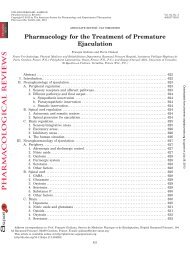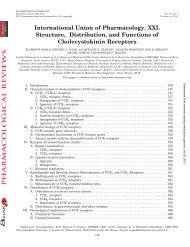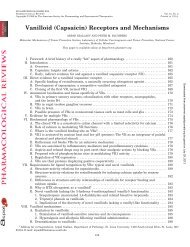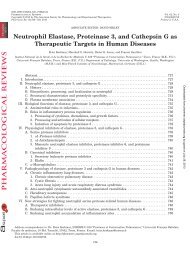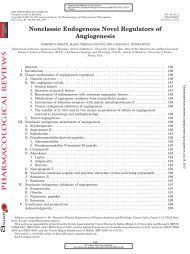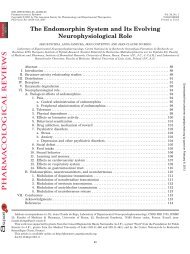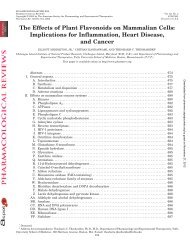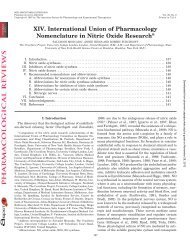Opioids, Reward and Addiction: An Encounter of Biology ...
Opioids, Reward and Addiction: An Encounter of Biology ...
Opioids, Reward and Addiction: An Encounter of Biology ...
You also want an ePaper? Increase the reach of your titles
YUMPU automatically turns print PDFs into web optimized ePapers that Google loves.
Villanúa MA <strong>and</strong> Navarro M (1998) Maternal exposure to low doses <strong>of</strong> 9 -<br />
tetrahydrocannabinol facilitates morphine-induced place conditioning in adult<br />
male <strong>of</strong>fspring. Pharmacol Biochem Behav 61:229–238.<br />
Sala M, Braida D, Calcaterra P, Leone MP <strong>and</strong> Gori E (1992) Dose-dependent<br />
conditioned place preference produced by etonitazene <strong>and</strong> morphine. Eur J Pharmacol<br />
217:37–41.<br />
Salamone JD (1996) The behavioral neurochemistry <strong>of</strong> motivation: Methodological<br />
<strong>and</strong> conceptual issues in studies <strong>of</strong> the dynamic activity <strong>of</strong> nucleus accumbens<br />
dopamine. J Neurosci Methods 64:137–149.<br />
Samson HH <strong>and</strong> Doyle TF (1985) Oral ethanol self-administration in the rat: Effect<br />
<strong>of</strong> naloxone. Pharmacol Biochem Behav 22:91–99.<br />
S<strong>and</strong>i C, Borrell J <strong>and</strong> Guaza C (1988) Naloxone decreases ethanol consumption<br />
within a free choice paradigm in rats. Pharmacol Biochem Behav 29:39–43.<br />
S<strong>and</strong>i C, Borrell J <strong>and</strong> Guaza C (1989) -Endorphin administration interferes with<br />
the acquisition <strong>and</strong> initial maintenance <strong>of</strong> ethanol preference in the rat. Physiol<br />
Behav 45:87–92.<br />
S<strong>and</strong>i C, Borrell J <strong>and</strong> Guaza C (1990a) Administration <strong>of</strong> leu-enkephalin impairs<br />
the acquisition <strong>of</strong> preference for ethanol. Psychopharmacology 100:350–354.<br />
S<strong>and</strong>i C, Borrell J <strong>and</strong> Guaza C (1990b) D-Ala 2 -Met 5 -enkephalinamide impairs the<br />
acquisition <strong>of</strong> ethanol preference without influencing sucrose preference. Physiol<br />
Behav 48:435–439.<br />
Satinder KP (1977) Oral intake <strong>of</strong> morphine in selectively bred rats. Pharmacol<br />
Biochem Behav 7:43–49.<br />
Schaefer GJ (1988) Opiate antagonists <strong>and</strong> rewarding brain stimulation. Neurosci<br />
Biobehav Rev 12:1–17.<br />
Schaefer GJ <strong>and</strong> Holtzman SG (1977) Dose- <strong>and</strong> time-dependent effects <strong>of</strong> narcotic<br />
analgesics on intracranial self-stimulation in the rat. Psychopharmacology 53:<br />
227–234.<br />
Schaefer GJ <strong>and</strong> Holtzman SG (1979) Free-operant <strong>and</strong> auto-titration brain selfstimulation<br />
procedures in the rat: A comparison <strong>of</strong> drug effects. Pharmacol Biochem<br />
Behav 10:127–135.<br />
Schaefer GJ <strong>and</strong> Michael RP (1981) Threshold differences for naloxone <strong>and</strong> naltrexone<br />
in the hypothalamus <strong>and</strong> midbrain using fixed-ratio brain self-stimulation in<br />
rats. Psychopharmacology 74:17–22.<br />
Schaefer GJ <strong>and</strong> Michael RP (1985) Effects <strong>of</strong> opioid antagonists <strong>and</strong> their quaternary<br />
derivatives on locomotor activity <strong>and</strong> fixed-ratio responding for brain selfstimulation<br />
in rats. Pharmacol Biochem Behav 23:797–802.<br />
Schaefer GJ <strong>and</strong> Michael RP (1987) Ethanol <strong>and</strong> current thresholds for brain<br />
self-stimulation in the lateral hypothalamus <strong>of</strong> the rat. Alcohol 4:209–213.<br />
Schaefer GJ <strong>and</strong> Michael RP (1988a) Naloxone <strong>and</strong> diprenorphine reduce responding<br />
for brain self-stimulation in a fixed-ratio schedule in rats. Pharmacol Biochem<br />
Behav 29:209–212.<br />
Schaefer GJ <strong>and</strong> Michael RP (1988b) <strong>An</strong> analysis <strong>of</strong> the effects <strong>of</strong> amphetamine on<br />
brain self-stimulation behavior. Behav Brain Res 29:93–101.<br />
Schaefer GJ <strong>and</strong> Michael RP (1990) Interactions <strong>of</strong> naloxone with morphine, amphetamine<br />
<strong>and</strong> phencyclidine on fixed-interval responding for intracranial selfstimulation<br />
in rats. Psychopharmacology 102:263–268.<br />
Schechter MD <strong>and</strong> Calcagnetti DJ (1993) Trends in place preference conditioning<br />
with a cross-indexed bibliography: 1957–1991. Neurosci Biobehav Rev 17:21–41.<br />
Schenk S, Coupal A, Williams T <strong>and</strong> Shizgal P (1981) A within-subject comparison <strong>of</strong><br />
the effects <strong>of</strong> morphine on lateral hypothalamic <strong>and</strong> central grey self-stimulation.<br />
Pharmacol Biochem Behav 15:37–41.<br />
Schenk S, Ellison F, Hunt T <strong>and</strong> Amit Z (1985) <strong>An</strong> examination <strong>of</strong> heroin conditioning<br />
in preferred <strong>and</strong> nonpreferred environments <strong>and</strong> in differentially housed<br />
mature <strong>and</strong> immature rats. Pharmacol Biochem Behav 22:215–220.<br />
Schenk S, Hunt T, Colle L <strong>and</strong> Amit Z (1983) Isolation versus grouped housing in<br />
rats: Differential effects <strong>of</strong> low doses <strong>of</strong> heroin in the place preference paradigm.<br />
Life Sci 32:1129–1134.<br />
Schenk S <strong>and</strong> Nawiesniak E (1985) Chronic naltrexone treatment increases the<br />
heroin-produced facilitation <strong>of</strong> self-stimulation. Pharmacol Biochem Behav 22:<br />
175–177.<br />
Schildein S, Ågmo A, Huston JP <strong>and</strong> Schwarting RKW (1998) Intraaccumbens<br />
injections <strong>of</strong> substance P, morphine <strong>and</strong> amphetamine: Effects on conditioned<br />
place preference <strong>and</strong> behavioral activity. Brain Res 790:185–194.<br />
Schneirla TC (1959) <strong>An</strong> evolutionary <strong>and</strong> developmental theory <strong>of</strong> biphasic processes<br />
underlying approach <strong>and</strong> withdrawal, in Nebraska Symposium on Motivation<br />
(Jones MR ed) pp 1–42, University <strong>of</strong> Nebraska Press, Lincoln.<br />
Sch<strong>of</strong>felmeer ANM, De Vries TJ, Hogenboom F, Hruby VJ, Portoghese PS <strong>and</strong><br />
Mulder AH (1992) Opioid receptor antagonists discriminate between presynaptic<br />
- <strong>and</strong> - receptors <strong>and</strong> the adenylate cyclase-coupled opioid receptor complex in<br />
the brain. J Pharmacol Exp Ther 263:20–24.<br />
Sch<strong>of</strong>felmeer ANM, De Vries TJ, Hogenboom F <strong>and</strong> Mulder AH (1993) “mu”- <strong>and</strong><br />
“delta”-opioid receptors inhibitorily linked to dopamine-sensitive adenylate cyclase<br />
in rat striatum display a selectivity pr<strong>of</strong>ile toward endogenous opioid peptides<br />
different from that <strong>of</strong> presynaptic -, - <strong>and</strong> - receptors. J Pharmacol Exp Ther<br />
267:205–210.<br />
Schulteis G <strong>and</strong> Koob GF (1996) Reinforcement processes in opiate addiction: A<br />
homeostatic model. Neurochem Res 21:1437–1454.<br />
Schulteis G, Stinus L, Risbrough VB <strong>and</strong> Koob GF (1998) Clonidine blocks acquisition<br />
but not expression <strong>of</strong> conditioned opiate withdrawal in rats. Neuropsychopharmacology<br />
19:406–416.<br />
Schulz R, Wüster M, Duka T <strong>and</strong> Herz A (1980) Acute <strong>and</strong> chronic ethanol treatment<br />
changes endorphin levels in brain <strong>and</strong> pituitary. Psychoparmacology 68:221–227.<br />
Schultz W, Dayan P <strong>and</strong> Montague PR (1997) A neural substrate <strong>of</strong> prediction <strong>and</strong><br />
reward. Science (Wash DC) 275:1593–1599.<br />
Schuster CR <strong>and</strong> Woods JH (1968) The conditioned reinforcing effects <strong>of</strong> stimuli<br />
associated with morphine reinforcement. Int J Addict 3:223–230.<br />
Schwarz-Stevens KS, Files FJ <strong>and</strong> Samson HH (1992) Effects <strong>of</strong> morphine <strong>and</strong><br />
naloxone on ethanol- <strong>and</strong> sucrose-reinforced responding in nondeprived rats. Alcohol<br />
Clin Exp Res 16:822–832.<br />
OPIOIDS, REWARD AND ADDICTION 393<br />
Schwartz AS <strong>and</strong> Marchok PL (1974) Depression <strong>of</strong> morphine seeking behavior by<br />
dopamine inhibition. Nature (Lond) 248:257–258.<br />
Scoles MT <strong>and</strong> Siegel S (1986) A potential role <strong>of</strong> saline trials in morphine-induced<br />
place-preference conditioning. Pharmacol Biochem Behav 25:1169–1173.<br />
Seizinger BR, Bovermann K, Maysinger D, Höllt V <strong>and</strong> Herz A (1983) Differential<br />
effects <strong>of</strong> acute <strong>and</strong> chronic ethanol treatment on particular opioid peptide systems<br />
in discrete regions <strong>of</strong> rat brain <strong>and</strong> pituitary. Pharmacol Biochem Behav 18:361–<br />
369.<br />
Self DW <strong>and</strong> Nestler EJ (1995) Molecular mechanisms <strong>of</strong> drug reinforcement <strong>and</strong><br />
addiction. <strong>An</strong>nu Rev Neurosci 18:463–495.<br />
Self DW, Terwilliger RZ, Nestler EJ <strong>and</strong> Stein L (1994) Inactivation <strong>of</strong> G(i) <strong>and</strong> G(o)<br />
proteins in nucleus accumbens reduces both cocaine <strong>and</strong> heroin reinforcement.<br />
J Neurosci 14:6239–6247.<br />
Sertürner FWA (1806) Darstellung der reinen Mohnsäure (Opiumsure), nebst einer<br />
chemischen Untersuchung des Opiums. J Pharmacol 14:47–93.<br />
Shaham Y, Alvares K, Nespor SM <strong>and</strong> Grunberg NE (1992) Effect <strong>of</strong> stress on oral<br />
morphine <strong>and</strong> fentanyl self-administration in rats. Pharmacol Biochem Behav<br />
41:615–619.<br />
Shaham Y, Funk D, Erb S, Brown TJ, Walker CD <strong>and</strong> Stewart J (1997) Corticotropin-releasing<br />
factor, but not corticosterone, is involved in stress-induced relapse to<br />
heroin-seeking in rats. J Neurosci 17:2605–2614.<br />
Shaham Y, Rajabi H <strong>and</strong> Stewart J (1996) Relapse to heroin-seeking under opioid<br />
maintenance: The effects <strong>of</strong> opioid withdrawal, heroin priming <strong>and</strong> stress. J Neurosci<br />
16:1957–1963.<br />
Shaham Y <strong>and</strong> Stewart J (1994) Exposure to mild stress enhances the reinforcing<br />
efficacy <strong>of</strong> intravenous heroin self-administration in rats. Psychopharmacology<br />
114:523–527.<br />
Shaham Y <strong>and</strong> Stewart J (1995) Stress reinstates heroin-seeking in drug-free animals:<br />
<strong>An</strong> effect mimicking heroin, not withdrawal. Psychopharmacology 119:334–<br />
341.<br />
Shaham Y <strong>and</strong> Stewart J (1996) Effects <strong>of</strong> opioid <strong>and</strong> dopamine receptor antagonists<br />
on relapse induced by stress <strong>and</strong> re-exposure to heroin in rats. Psychopharmacology<br />
125:385–391.<br />
Shani J <strong>and</strong> Azov R (1979) Enkephalin levels in rat brain after various regimens <strong>of</strong><br />
morphine administration. Neurosci Lett 12:319–323.<br />
Shaw SG, Vives F <strong>and</strong> Mora F (1984) Opioid peptides <strong>and</strong> self-stimulation <strong>of</strong> the<br />
medial prefrontal cortex in the rat. Psychopharmacology 83:288–292.<br />
Shippenberg TS <strong>and</strong> Bals-Kubik R (1995) Involvement <strong>of</strong> the mesolimbic dopamine<br />
system in mediating the aversive effects <strong>of</strong> opioid antagonists in the rat. Behav<br />
Pharmacol 6:99–106.<br />
Shippenberg TS, Bals-Kubik R <strong>and</strong> Herz A (1987) Motivational properties <strong>of</strong> opioids:<br />
evidence that an activation <strong>of</strong> -receptors mediates reinforcement processes. Brain<br />
Res 436:234–239.<br />
Shippenberg TS, Bals-Kubik R <strong>and</strong> Herz A (1993) Examination <strong>of</strong> the neurochemical<br />
substrates mediating the motivational effects <strong>of</strong> opioids: Role <strong>of</strong> the mesolimbic<br />
dopamine system <strong>and</strong> D-1 vs. D-2 dopamine receptors. J Pharmacol Exp Ther<br />
265:53–59.<br />
Shippenberg TS, Emmett-Oglesby MW, Ayesta FJ <strong>and</strong> Herz A (1988a) Tolerance <strong>and</strong><br />
selective cross-tolerance to the motivational effects <strong>of</strong> opioids. Psychopharmacology<br />
96:110–115.<br />
Shippenberg TS <strong>and</strong> Heidbreder C (1995a) The -opioid receptor antagonist naltrindole<br />
prevents sensitization to the conditioned rewarding effects <strong>of</strong> cocaine. Eur<br />
J Pharmacol 280:55–61.<br />
Shippenberg TS <strong>and</strong> Heidbreder C (1995b) Sensitization to the conditioned rewarding<br />
effects <strong>of</strong> cocaine: Pharmacological <strong>and</strong> temporal characteristics. J Pharmacol<br />
Exp Ther 273:808–815.<br />
Shippenberg TS, Heidbreder C <strong>and</strong> LeFevour A (1996a) Sensitization to the conditioned<br />
rewarding effects <strong>of</strong> morphine: Pharmacology <strong>and</strong> temporal characteristics.<br />
Eur J Pharmacol 299:33–39.<br />
Shippenberg TS <strong>and</strong> Herz A (1987) Place preference conditioning reveals the involvement<br />
<strong>of</strong> D1-dopamine receptors in the motivational properties <strong>of</strong> - <strong>and</strong> -opioid<br />
agonists. Brain Res 436:169–172.<br />
Shippenberg TS <strong>and</strong> Herz A (1988) Motivational effects <strong>of</strong> opioids: influence <strong>of</strong> D-1<br />
versus D-2 receptor antagonists. Eur J Pharmacol 151:233–242.<br />
Shippenberg TS <strong>and</strong> Herz A (1991) Influence <strong>of</strong> chronic lithium treatment upon the<br />
motivational effects <strong>of</strong> opioids: Alteration in the effects <strong>of</strong> - but not -opioid<br />
receptor lig<strong>and</strong>s. J Pharmacol Exp Ther 256:1101–1106.<br />
Shippenberg TS, LeFevour A <strong>and</strong> Heidbreder C (1996b) -Opioid receptor agonists<br />
prevent sensitization to the conditioned rewarding effects <strong>of</strong> cocaine. J Pharmacol<br />
Exp Ther 276:545–554.<br />
Shippenberg TS, LeFevour A <strong>and</strong> Thompson AC (1998) Sensitization to the conditioned<br />
rewarding effects <strong>of</strong> morphine <strong>and</strong> cocaine: Differential effects <strong>of</strong> the -opioid<br />
receptor agonist U69593. Eur J Pharmacol 345:27–34.<br />
Shippenberg TS, Millan MJ, Mucha RF <strong>and</strong> Herz A (1988b) Involvement <strong>of</strong> -endorphin<br />
<strong>and</strong> -opioid receptors in mediating the aversive effect <strong>of</strong> lithium in the rat.<br />
Eur J Pharmacol 154:135–144.<br />
Shippenberg TS <strong>and</strong> Rea W (1997) Sensitization to the behavioral effects <strong>of</strong> cocaine:<br />
modulation by dynorphin <strong>and</strong> -opioid receptor agonists. Pharmacol Biochem<br />
Behav 57:449–455.<br />
Simon EJ, Hiller JM <strong>and</strong> Edelman I (1973) Stereospecific binding <strong>of</strong> the potent<br />
narcotic analgesic [ 3 H]etorphine to rat-brain homogenate. Proc Natl Acad Sci USA<br />
70:1947–1949.<br />
Sinclair JD (1974) Morphine suppresses alcohol drinking regardless <strong>of</strong> prior alcohol<br />
access duration. Pharmacol Biochem Behav 2:409–412.<br />
Sinclair JD, Adkins J <strong>and</strong> Walker S (1973) Morphine-induced suppression <strong>of</strong> voluntary<br />
alcohol drinking in rats. Nature (Lond) 246:425–427.<br />
Sinden JD, Marfaing Jallat P <strong>and</strong> Le Magnen J (1983) The effect <strong>of</strong> naloxone on<br />
intragastric ethanol self-administration. Pharmacol Biochem Behav 19:1045–<br />
1048.<br />
Singer G <strong>and</strong> Wallace M (1984) Effects <strong>of</strong> 6-OHDA lesions in the nucleus accumbens



